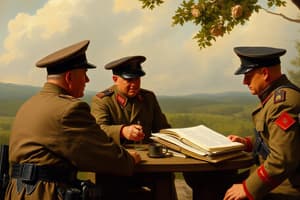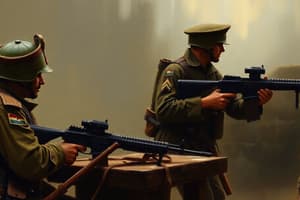Podcast
Questions and Answers
Which of the following is NOT a benefit of using the full MDMP?
Which of the following is NOT a benefit of using the full MDMP?
- It results in a more thorough OPLAN or OPORD.
- It enables a better understanding of the situation and problem to solve.
- It helps identify contingencies for branch and sequel development.
- It requires minimal time and effort from the staff. (correct)
What is the primary disadvantage of using the full MDMP?
What is the primary disadvantage of using the full MDMP?
- It can lead to misunderstandings and confusion among the staff.
- It can be time-consuming and resource-intensive. (correct)
- It requires significant input from the commander but not the staff.
- It limits the ability to adapt to changing circumstances.
How does the MDMP facilitate interaction between the commander, staff, and subordinate headquarters?
How does the MDMP facilitate interaction between the commander, staff, and subordinate headquarters?
- It provides a hierarchical structure that ensures clear lines of communication.
- It establishes a formal process for developing and disseminating plans.
- It encourages feedback and iteration throughout the planning process. (correct)
- It defines roles and responsibilities for each member of the command.
What is the role of WARNORDs in the MDMP?
What is the role of WARNORDs in the MDMP?
What is the primary benefit of using the full MDMP?
What is the primary benefit of using the full MDMP?
What is the role of the commander in the MDMP?
What is the role of the commander in the MDMP?
Which of the following is NOT a reason why using the full MDMP can be detrimental?
Which of the following is NOT a reason why using the full MDMP can be detrimental?
Why is the full MDMP essential to mastering the abbreviated MDMP?
Why is the full MDMP essential to mastering the abbreviated MDMP?
What is a constraint in the context of military planning?
What is a constraint in the context of military planning?
What is the purpose of conducting an initial assessment of resources during the planning process?
What is the purpose of conducting an initial assessment of resources during the planning process?
Which of the following is NOT considered a constraint in military planning?
Which of the following is NOT considered a constraint in military planning?
Where are constraints typically found in military plans and orders?
Where are constraints typically found in military plans and orders?
What is the main difference between a fact and an assumption in military planning?
What is the main difference between a fact and an assumption in military planning?
What is the role of the staff judge advocate during the military planning process?
What is the role of the staff judge advocate during the military planning process?
How do deviations from the normal task organization affect military planning?
How do deviations from the normal task organization affect military planning?
What is the primary purpose of analyzing available assets during the COA development phase?
What is the primary purpose of analyzing available assets during the COA development phase?
What is the main purpose of conducting a relative combat power assessment?
What is the main purpose of conducting a relative combat power assessment?
What are decision points primarily identified by planners?
What are decision points primarily identified by planners?
What factors may dominate during stability or defense operations according to the assessment?
What factors may dominate during stability or defense operations according to the assessment?
What aspect is critical for planners to understand when developing a Course of Action (COA)?
What aspect is critical for planners to understand when developing a Course of Action (COA)?
What is a key outcome of brainstorming when generating options?
What is a key outcome of brainstorming when generating options?
What must planners determine when developing Courses of Action (COAs) for proposed operations?
What must planners determine when developing Courses of Action (COAs) for proposed operations?
Which forces are necessary for a deliberate breach operation?
Which forces are necessary for a deliberate breach operation?
What does the commander's intent help determine in planning?
What does the commander's intent help determine in planning?
What is the primary role of staffs in relation to the commander?
What is the primary role of staffs in relation to the commander?
How do staffs assess the viability of options during operations?
How do staffs assess the viability of options during operations?
Which of the following is NOT an element of combat power?
Which of the following is NOT an element of combat power?
What is the objective of generating overwhelming combat power?
What is the objective of generating overwhelming combat power?
Which variables can hinder mission accomplishment?
Which variables can hinder mission accomplishment?
What method is suggested for visualizing interactions of mission variables?
What method is suggested for visualizing interactions of mission variables?
What should staffs focus on when developing courses of action (COAs)?
What should staffs focus on when developing courses of action (COAs)?
Which aspect is crucial to decision-making during execution?
Which aspect is crucial to decision-making during execution?
What is the first step in the risk management process?
What is the first step in the risk management process?
Which option best describes 'Very likely' in military risk probability?
Which option best describes 'Very likely' in military risk probability?
What does a 'High' consequence in military risk indicate?
What does a 'High' consequence in military risk indicate?
How do planners determine military risk?
How do planners determine military risk?
What is the purpose of risk management?
What is the purpose of risk management?
Which of the following is NOT a categorization of probability in military risk?
Which of the following is NOT a categorization of probability in military risk?
Which step is involved in the risk management process after assessing hazards?
Which step is involved in the risk management process after assessing hazards?
What characterizes military risk according to the text?
What characterizes military risk according to the text?
Which type of guidance is essential for understanding the rules of engagement in military planning?
Which type of guidance is essential for understanding the rules of engagement in military planning?
What is a primary factor to consider when forming a course of action in military operations?
What is a primary factor to consider when forming a course of action in military operations?
Which of the following options does NOT fall under the planning and operational guidance timeline?
Which of the following options does NOT fall under the planning and operational guidance timeline?
Which guidance is crucial for managing risks in military operations?
Which guidance is crucial for managing risks in military operations?
What aspect is included in the intelligence planning guidance?
What aspect is included in the intelligence planning guidance?
What is a key concern under the fires warfighting function?
What is a key concern under the fires warfighting function?
Which of the following is a priority consideration for the protection warfighting function?
Which of the following is a priority consideration for the protection warfighting function?
What does the term 'task and purpose of fires' refer to in military planning?
What does the term 'task and purpose of fires' refer to in military planning?
Which item is typically NOT part of the sustainment priorities in military operations?
Which item is typically NOT part of the sustainment priorities in military operations?
What should be monitored to ensure effective risk management during military operations?
What should be monitored to ensure effective risk management during military operations?
Which of the following is an example of critical events in military planning?
Which of the following is an example of critical events in military planning?
What is a critical aspect related to 'Civil affairs operations' in military planning?
What is a critical aspect related to 'Civil affairs operations' in military planning?
Which component is NOT typically included in the command and control planning guidance?
Which component is NOT typically included in the command and control planning guidance?
What type of planning guidance helps determine the best approach for maneuver units?
What type of planning guidance helps determine the best approach for maneuver units?
Flashcards
MDMP
MDMP
Military Decision-Making Process that structures planning.
Advantages of full MDMP
Advantages of full MDMP
Benefits include better understanding and COA comparison.
Disadvantages of full MDMP
Disadvantages of full MDMP
Time and resource-intensive, risking lost momentum.
COAs
COAs
Signup and view all the flashcards
Shared understanding
Shared understanding
Signup and view all the flashcards
WARNORDs
WARNORDs
Signup and view all the flashcards
Interaction in MDMP
Interaction in MDMP
Signup and view all the flashcards
Role of the Commander
Role of the Commander
Signup and view all the flashcards
Technical Effects
Technical Effects
Signup and view all the flashcards
Initial Assessment
Initial Assessment
Signup and view all the flashcards
Constraints
Constraints
Signup and view all the flashcards
OPLAN/OPORD
OPLAN/OPORD
Signup and view all the flashcards
Resource Limitations
Resource Limitations
Signup and view all the flashcards
Facts
Facts
Signup and view all the flashcards
Assumptions
Assumptions
Signup and view all the flashcards
Legal Constraints
Legal Constraints
Signup and view all the flashcards
Relative Combat Power Assessment
Relative Combat Power Assessment
Signup and view all the flashcards
Decision Points
Decision Points
Signup and view all the flashcards
Generating Options
Generating Options
Signup and view all the flashcards
Commander’s Intent
Commander’s Intent
Signup and view all the flashcards
Courses of Action (COAs)
Courses of Action (COAs)
Signup and view all the flashcards
Doctrinal Requirements
Doctrinal Requirements
Signup and view all the flashcards
Essential Stability Tasks
Essential Stability Tasks
Signup and view all the flashcards
Unified Action Partners
Unified Action Partners
Signup and view all the flashcards
Preliminary Risk Assessment
Preliminary Risk Assessment
Signup and view all the flashcards
Military Risk Assessment
Military Risk Assessment
Signup and view all the flashcards
Probability Categories
Probability Categories
Signup and view all the flashcards
Consequence Levels
Consequence Levels
Signup and view all the flashcards
Risk Management Process
Risk Management Process
Signup and view all the flashcards
Steps in Risk Management
Steps in Risk Management
Signup and view all the flashcards
Hazard Identification
Hazard Identification
Signup and view all the flashcards
Risk Perspective
Risk Perspective
Signup and view all the flashcards
Critical Options
Critical Options
Signup and view all the flashcards
Viable Options
Viable Options
Signup and view all the flashcards
Risk Identification
Risk Identification
Signup and view all the flashcards
Combat Power
Combat Power
Signup and view all the flashcards
Assessing Options
Assessing Options
Signup and view all the flashcards
Sketch for Planning
Sketch for Planning
Signup and view all the flashcards
Overwhelming Combat Power
Overwhelming Combat Power
Signup and view all the flashcards
COA Approval
COA Approval
Signup and view all the flashcards
Planning Guidance
Planning Guidance
Signup and view all the flashcards
Warfighting Function
Warfighting Function
Signup and view all the flashcards
Rules of Engagement
Rules of Engagement
Signup and view all the flashcards
Critical Information Requirements
Critical Information Requirements
Signup and view all the flashcards
Tactical Deception
Tactical Deception
Signup and view all the flashcards
Scheme of Fires
Scheme of Fires
Signup and view all the flashcards
Mobility
Mobility
Signup and view all the flashcards
Protection Priorities
Protection Priorities
Signup and view all the flashcards
Health Service Support
Health Service Support
Signup and view all the flashcards
Sustainment Priorities
Sustainment Priorities
Signup and view all the flashcards
Critical Terrain Factors
Critical Terrain Factors
Signup and view all the flashcards
Intel Focus
Intel Focus
Signup and view all the flashcards
Operational Framework
Operational Framework
Signup and view all the flashcards
Study Notes
The Military Decision-Making Process (MDMP)
- The MDMP is an iterative planning process used by military commanders and staffs to organize and conduct planning activities
- It is applicable across the range of military operations, from military engagements to large-scale combat operations and crisis response.
- The seven steps of the MDMP are:
- Step 1 - Receipt of mission: Commanders receive the mission from their higher echelon headquarters or anticipate a new mission.
- Step 2 - Mission analysis: This involves analyzing the higher headquarters' plan, order, situation, and the unit's contribution to the overall mission. It involves using intelligence preparation of the battlefield (IPB).
- Step 3 - COA development: This step involves generating multiple courses of action (COAs) to be considered. This step often involves the use of ADM for problem framing.
- Step 4 - COA analysis: This step involves analyzing each course of action (COA) for their strengths, weaknesses, probable consequences, risk of each COA, and the time constraints.
- Step 5 - COA comparison: This step is the process of evaluating different courses of action (COAs). Advantages, disadvantages, limitations, and costs are compared against the evaluation criteria set in the previous steps. Use of decision matrices may help in this step.
- Step 6 - COA approval: This step involves the commander selecting the best COA to take action (or initiating a return to COA development), based on staff analysis and recommendations.
- Step 7 - Orders production, dissemination, and transition: This step involves producing and issuing the final order or plan, ensuring all relevant information is communicated.
Modifying the MDMP in a Time-Constrained Environment
- The MDMP should be as detailed as time permits.
- Commanders may abbreviate steps of the MDMP as needed.
- ADM (Army design methodology) can be utilized if time permits before conducting the MDMP.
- The MDMP facilitates collaborative planning by sharing information among organizations.
Commander, Staff, and Subordinate Headquarters Interaction
- The MDMP facilitates interaction throughout all levels.
- This interaction allows for a well-coordinated effort.
- WARNORDs facilitate parallel planning by providing relevant information to subordinate organizations.
Role of the Commander
- Commanders are the primary decision-makers in the MDMP.
- They provide guidance, make decisions, and supervise planning efforts.
- They ensure that the staff's plans adequately reflect their visualization of the situation.
Studying That Suits You
Use AI to generate personalized quizzes and flashcards to suit your learning preferences.




